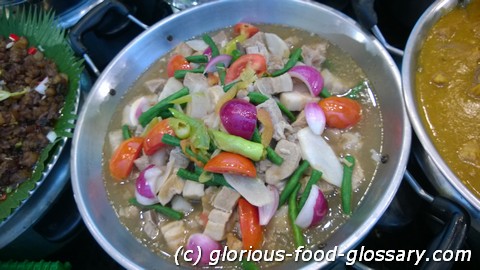Deutsch: Schweinefleisch in saurer Brühe / Español: Cerdo en Caldo Agrio / Português: Porco em Caldo Azedo / Français: Porc dans un Bouillon Aigre / Italiano: Maiale in Brodo Aspro
Sinigang na Baboy is a classic Filipino dish known for its sour and savory flavors, primarily featuring pork (baboy) simmered in a tangy broth. The sourness traditionally comes from tamarind (sampalok), although other souring agents like kamias (bilimbi), green Mango, or calamansi can also be used, depending on the region or personal preference. The dish includes a variety of vegetables such as water spinach (kangkong), Daikon radish (Labanos), eggplant (talong), and string beans (sitaw), making it a hearty and comforting meal.
Description
The essence of Sinigang na Baboy lies in its broth, which is both rich in flavor and aromatic, thanks to the Blend of souring agents, pork, and vegetables. The pork is typically cut into chunks, allowing it to absorb the tangy flavors of the broth and tenderize over the slow cooking process. This dish is a staple in Filipino cuisine, embodying the balance of sourness, slight sweetness, and savory depth that is characteristic of many Filipino stews.
Application Areas
Sinigang na Baboy is commonly served as a main dish across the Philippines, enjoyed with rice. It's a versatile recipe that can be adapted to suit different tastes and occasions, from everyday family meals to gatherings and celebrations. Its comforting warmth makes it especially popular during the rainy season or cooler months, though it's enjoyed year-round.
Well-Known Examples
While Sinigang na Baboy is a standout dish on its own, the sinigang family includes various other versions such as Sinigang na Hipon (with shrimp), Sinigang na Bangus (with milkfish), and Sinigang na Baka (with beef). Each variant uses a similar sour broth as the base but showcases different proteins, demonstrating the versatility of the sinigang concept in Filipino culinary tradition.
Treatment and Risks
As a well-balanced dish with protein, vegetables, and a richly flavored broth, Sinigang na Baboy is nutritionally beneficial, offering vitamins and minerals from the vegetables and protein from the pork. However, those on a low-sodium diet should moderate their intake due to the potential salt content, which can vary depending on the recipe. Proper preparation and cooking ensure the pork is tender and safe to eat, while the abundance of vegetables adds to the dish's healthfulness.
Summary
Sinigang na Baboy represents the heartwarming and vibrant nature of Filipino cuisine, with its unique combination of sourness and savory flavors. This dish not only offers a taste of the Philippines' rich culinary heritage but also brings comfort and satisfaction to those who enjoy it, making it a beloved meal for many Filipino families and a delightful discovery for culinary enthusiasts around the world.
--

Related Articles to the term 'Sinigang na Baboy' | |
| 'Sinaing na Tulingan' | ■■■■■■■■■■ |
| Sinaing na Tulingan is a traditional Filipino dish originating from the Batangas region, known for its . . . Read More | |
| 'Sinigang' | ■■■■■■■■■■ |
| Sinigang refers to Filipino method of cooking meats, fish or vegetables with sour fruit, like tamarind, . . . Read More | |
| 'Sampalok' | ■■■■■■■■■ |
| Sampalok is a Filipino word for Tamarind. In the Philippines its pulp/fruit are eaten and used as a souring . . . Read More | |
| 'Batwan / Batuan' | ■■■■■■■■■ |
| Batwan / Batuan: Batwan refers to a green sour fruit which is used as a souring agent for making Sinigang . . . Read More | |
| 'Puno ng Kamias' | ■■■■■■■■■ |
| Puno ng Kamias refers to the tree bearing kamias (Averrhoa bilimbi), a tropical fruit native to Southeast . . . Read More | |
| 'Kamias' | ■■■■■■■■ |
| Kamias is a Filipino fruit with scientific name Averrhoa bilimbi. The fruit is green and edible, about . . . Read More | |
| 'Batuan' | ■■■■■■■■ |
| Batuan is a tropical fruit primarily used as a souring agent in Filipino cuisine. This small, green fruit . . . Read More | |
| 'Ginisang Gulay' | ■■■■■■■■ |
| Ginisang Gulay in the food context refers to a Filipino dish consisting of sautéed vegetables. It is . . . Read More | |
| 'Giniling na Munggo' | ■■■■■■■ |
| Giniling na Munggo in the food context refers to a Filipino dish made from ground or mashed mung beans . . . Read More | |
| 'Pinangat na Galunggong' | ■■■■■■■ |
| Pinangat na Galunggong is a Filipino culinary dish that features galunggong (round scad) cooked in a . . . Read More | |
